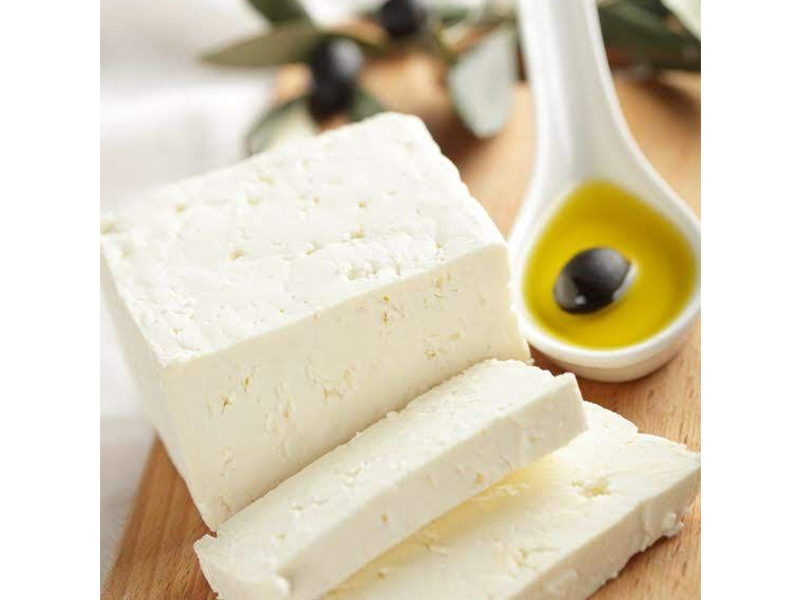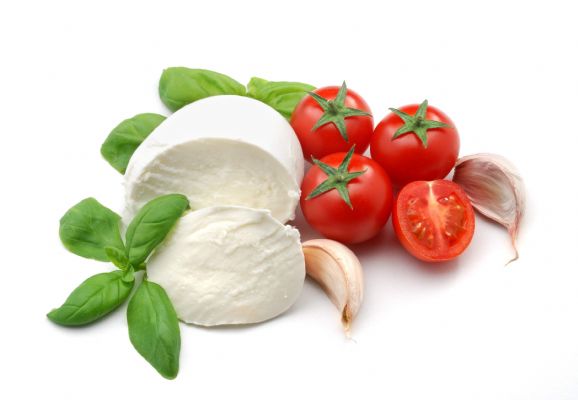
Feta is a soft brined white cheese with small or no holes, a compact touch, few cuts, and no skin. It is usually formed into large blocks, which are submerged in brine. Its flavor is tangy and salty, ranging from mild to sharp. Its maximum moisture is 56%, its minimum fat content in dry matter is 43%, and its pH usually ranges from 4.4 to 4.6. Feta is traditionally categorized into firm and soft varieties. The firm variety is tangier and considered higher in quality. The soft variety is almost soft enough to be spreadable, mostly used in pies and sold at a cheaper price. Slicing feta produces some amount of trímma, "crumble", which is also used for pies (not being saleable, trímma is usually given away for free upon request).
High-quality feta should have a creamy texture when sampled, and aromas of ewe's milk, butter, and yoghurt. In the mouth it is tangy, slightly salty, and mildly sour, with a spicy finish that recalls pepper and ginger, as well as a hint of sweetness.
Traditionally (and legally within the EU), feta is produced using only whole sheep's milk, or a blend of sheep's and goat's milk (with a maximum of 30% goat's milk). The milk may be pasteurized or not, but most producers now use pasteurized milk. If pasteurized milk is used, a starter culture of micro-organisms is added to replace those naturally present in raw milk which are killed in pasteurization. These organisms are required for acidity and flavour development. When the pasteurized milk has cooled to approximately 35 °C (95 °F), rennet is added and the casein is left to coagulate. The compacted curds are then chopped up and placed in a special mould or a cloth bag that allows the whey to drain. After several hours, the curd is firm enough to cut up and salt; salinity will eventually reach approximately 3%, when the salted curds are placed (depending on the producer and the area of Greece) in metal vessels or wooden barrels and allowed to infuse for several days. After the dry-salting of the cheese is complete, aging or maturation in brine (a 7% salt in water solution) takes several weeks at room temperature and a further minimum of 2 months in a refrigerated high-humidity environment—as before, either in wooden barrels or metal vessels, depending on the producer (the more traditional barrel aging is said to impart a unique flavour). The containers are then shipped to supermarkets where the cheese is cut and sold directly from the container; alternatively blocks of standardized weight are packaged in sealed plastic cups with some brine. Feta dries relatively quickly even when refrigerated; if stored for longer than a week, it should be kept in brine or lightly salted milk.
Though cheese made from sheep's or goat's milk is documented in Greece from the 8th century BC, and was widely consumed in ancient Greece and in later Greek gastronomy, feta cheese in particular is first recorded in the Byzantine period under the name prósphatos (Greek: πρόσφατος 'recent' or 'fresh'), and was produced by Cretans and the Vlachs of Thessaly. In the late 15th century, an Italian visitor to Candia, Pietro Casola, describes the marketing of feta, as well as its storage in brine.
The Greek word feta (φέτα) comes from the Italian word fetta 'slice', which in turn is derived from the Latin word offa ("a morsel", "piece"). It was introduced into the Greek language in the 17th century, became a widespread term in the 19th century, and probably refers to the practice of slicing cheese in order to place the slices into barrels.
source: https://en.m.wikipedia.org/wiki/Feta




